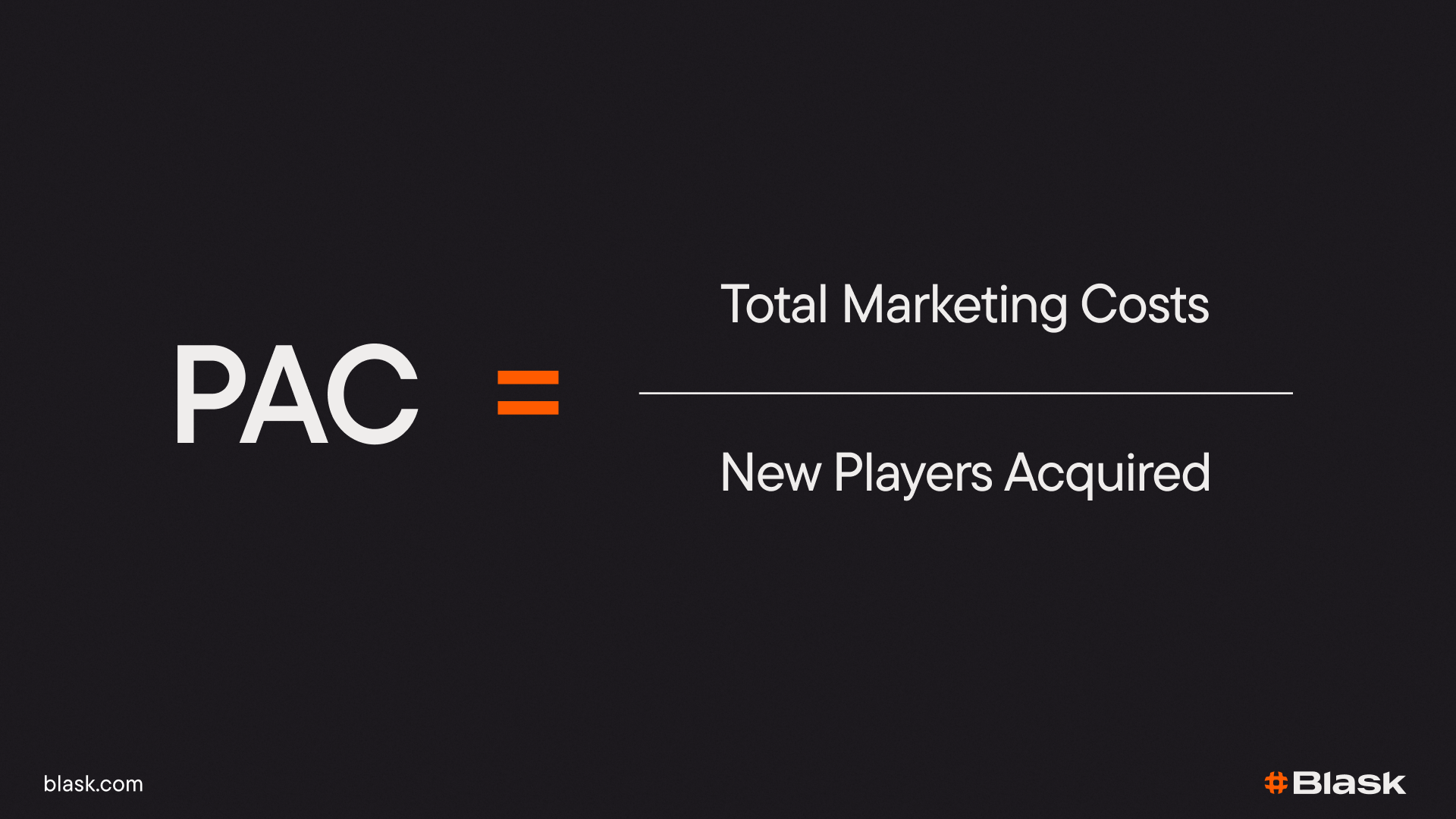Understanding player acquisition cost (PAC) in the iGaming industry
Player Acquisition Cost (PAC) is one of the most critical metrics in the iGaming industry. It measures how much you're spending to bring a new player onto your platform. A high PAC can drain your marketing budget quickly, while a low PAC can indicate effective marketing strategies. In this article, we’ll explore the importance of PAC, what factors influence it, and how you can optimize PAC with Blask’s AI-driven tools.
What is player acquisition cost (PAC)?
Player Acquisition Cost refers to the total marketing expenses required to bring in a new player. This includes all advertising, promotions, and bonuses.
The formula for PAC:

If your iGaming platform spent $15,000 on marketing and acquired 300 new players, the PAC would be:
$15,000 ÷ 300 = $50 per player
Why is PAC important in iGaming?
PAC is directly linked to profitability. If you’re spending more to acquire players than the revenue they generate, you’ll quickly find your budget stretched thin. In contrast, lowering PAC can lead to sustainable growth and increased profits.
Key reasons PAC matters:
- Profitability:
High PAC reduces your profit margins, while lowering PAC increases net revenue. - Marketing efficiency:
PAC helps evaluate the effectiveness of your marketing campaigns. A high PAC suggests inefficiencies. - Scalability:
Knowing PAC allows iGaming operators to budget and scale effectively, ensuring that growth strategies are sustainable. - Performance benchmarking:
It helps you understand how your campaigns stack up against industry standards and competitors.
Factors influencing PAC in the iGaming industry
Several factors contribute to PAC, and optimizing these can reduce your costs and improve ROI.
1. Marketing channels:
- Paid channels like Google Ads or social media ads usually have a higher upfront cost but deliver immediate player conversions.
- Organic strategies like SEO or influencer marketing tend to have a lower PAC but require more time to see results.
2. Bonuses and promotions:
- iGaming companies often use welcome bonuses and deposit matches to attract players. While these offers increase player acquisition, they also raise PAC since they are part of your acquisition expenses.
3. Market competition:
- In highly saturated markets, PAC is typically higher because iGaming operators have to spend more to stand out from the competition.
4. Brand awareness:
- Established brands with strong recognition can often acquire players at a lower cost, as players trust and are familiar with the brand.
How Blask helps optimize PAC
Optimizing PAC requires real-time data, trend analysis, and the ability to predict market behavior. Blask’s AI-powered tools provide operators with the information they need to make data-driven decisions.
Blask’s key tools to reduce PAC:
PAC optimization strategies
Here are some practical strategies to optimize PAC for your iGaming business:
1. Leverage data-driven marketing
Blask’s tools provide real-time insights into market trends, player behaviors, and competitor activity. Use these insights to refine your marketing campaigns, targeting the right audiences with the right messages.
2. Focus on retention
Reducing churn is essential. If you keep existing players engaged, you’ll need to spend less on acquiring new players. Blask provides player retention metrics, helping you identify which strategies are most effective at keeping players on your platform.
3. Optimize your marketing mix
Identify which channels deliver the highest conversion rates at the lowest costs. By analyzing your player acquisition from different channels, you can allocate your budget more effectively and lower PAC.
4. Monitor competitors
Use Blask’s Relative Market Share tool to compare your brand’s performance with competitors and adjust your acquisition strategies accordingly.
5. Test new markets
Blask’s Blask Index and eGGR metrics allow you to identify high-growth markets where the PAC may be lower. Expanding into new regions can help you acquire players at a lower cost.
The importance of Gross Gaming Revenue (GGR) in PAC calculation
While reducing PAC is important, it’s equally crucial to understand how much revenue each new player brings to your platform. This is where Gross Gaming Revenue (GGR) comes in. GGR measures the total income generated from iGaming activities (deposits minus payouts), giving you a clear picture of your profitability.
GGR vs PAC: a balancing act
By analyzing PAC and GGR together, iGaming operators can ensure that their player acquisition efforts are not only cost-effective but also profitable.
Conclusion: controlling PAC for long-term success
In the competitive iGaming industry, mastering PAC is crucial for profitability and growth. By leveraging Blask’s advanced AI-driven tools, including the Blask Index, eFTD, and eGGR, you can make data-driven decisions to reduce PAC while maintaining a steady flow of new players.
Blask empowers you with the insights needed to track competitors, optimize marketing spend, and understand how much value each new player brings to your platform.
Start optimizing your PAC with Blask today and take your iGaming business to new heights!
FAQs
How do I calculate PAC?
PAC is calculated by dividing your total marketing costs by the number of new players acquired:
PAC = Total Marketing Costs ÷ New Players Acquired
How can Blask help me reduce PAC?
Blask offers tools like the Blask Index, eFTD, and eGGR to track real-time data, predict trends, and optimize marketing efforts to lower PAC.
Why is it important to track both PAC and GGR?
While PAC measures the cost of acquiring new players, GGR evaluates the revenue generated by these players. Tracking both ensu